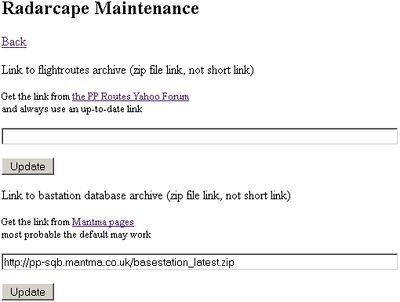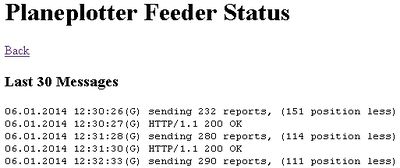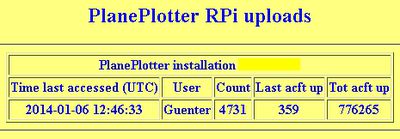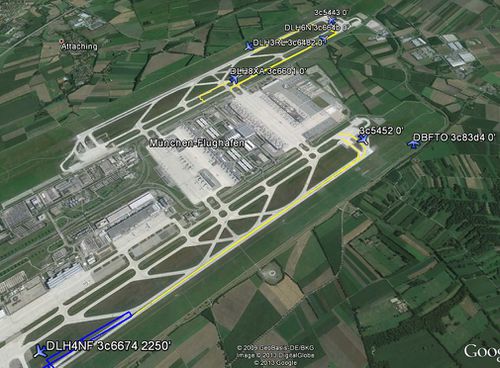Radarcape:Firmware Versions: Difference between revisions
remove python example code as it was wrong |
|||
| Line 10: | Line 10: | ||
Starting with November 2013, the release strategy will be Linux installer packages, which include the Linux software as well as the FPGA firmware. | Starting with November 2013, the release strategy will be Linux installer packages, which include the Linux software as well as the FPGA firmware. | ||
==Release_161030.00.00.30== | ==Release_161030.00.00.30== | ||
Latest revision as of 21:53, 8 November 2024
Software Packages
Starting with November 2013, the release strategy will be Linux installer packages, which include the Linux software as well as the FPGA firmware.
Release_161030.00.00.30
New Features:
- N/A
Bugfixes:
- Fixed: KML output
- Fixed: FR24 feeder does sometimes not stop during update
Known Bugs
- Platform independent:
- Logout screen is sometimes not properly displayed.
- After power on, the GPS may require up to 5 minutes until synchronisation. During this time, your GPS LED will not become green, also there won't be a feeder working.
- Disable FR24 feeder prior to the software upgrade and re-enable it when the new software release was installed successfully.
- Debian:
- none
- Angstrom:
- Angstrom devices may be inaccessible by SSH after a package installation and require a reboot.
Direct links to the packages
Debian radarcaped-161030.00.00.30.deb
Angstrom radarcaped-161030.00.00.30.opk
Release_160928.00.00.30
New Features:
- N/A (pure bugfix release)
Bugfixes:
- Fixed: Incorrect timestamp output in 12 MHz clock mode
- Fixed: Incorrect decoding of DF-17 surface positions
- Fixed: Configuration restore function
- Fixed: Missing link to PlanebaseNG
- Fixed: Map API key can now be configured via the configuration page
- Fixed: FPGA does no longer output dublicate frames in certain operation modes
- Fixed: Incorrect ground possition decoding
Known Bugs
- Platform independent:
- Logout screen is sometimes not properly displayed.
- After power on, the GPS may require up to 5 minutes until synchronisation. During this time, your GPS LED will not become green, also there won't be a feeder working.
- Disable FR24 feeder prior to the software upgrade and re-enable it when the new software release was installed successfully.
- Debian:
- none
- Angstrom:
- Angstrom devices may be inaccessible by SSH after a package installation and require a reboot.
Direct links to the packages
Debian radarcaped-160928.00.00.30.deb
Angstrom radarcaped-160928.00.00.30.opk
Release_160619.20.00.30
New Features:
- Configuration of static IP address via web interface
- Filters for altitude, speed, distance, ICAO hex codes on the 2D Map
- Save and restore settings to/from file
- Reboot button in the web interface
- Support of GLONASS (Only new Radarcape hardware releases with SMT360 GPS receiver)
- Factory reset function for the GPS module
Bugfixes:
- Fixed: Download location of basestation.sqb
- Fixed: Do not decode frames with ICAO equal to 0x000000 or 0xFFFFFF
- Fixed: Local clients cannot connect to UDP ports via loopback interface
- Fixed: Access control for JSON, KML, and TXT files via web interface
- Fixed: Occassional timestamp jumps in P30003 messages
Known Bugs
- Platform independent:
- Logout screen is sometimes not properly displayed.
- After power on, the GPS may require up to 5 minutes until synchronisation. During this time, your GPS LED will not become green, also there won't be a feeder working.
- Surface positions can be wrong by -90°, 90°, or 180°.
- Restore function does not work.
- Debian:
- none
- Angstrom:
- Angstrom devices may be inaccessible by SSH after a package installation and require a reboot.
Direct links to the packages
Debian radarcaped-160619.20.00.30.deb
Angstrom radarcaped-160619.20.00.30.opk
Release_151210.19.00.30
New Features:
- The Flightradar24 feeders in the previous Debian releases provided wrong locations to the server.
(Please note that the FR24 feeder is an external delivery and not under the same maintenance process like the rest of the firmware). - Flightradar24 and FPGA version were added to the System Information web page
Bugfixes:
- Since 01. December a login as Administrator results in an empty web page return. This bug is fixed with this release. The erroneous release 1121.19.20.30 was removed from the server
Those who already updated to the intermediate release 151204.08.00.30 should find this new version under Configuration - Software Maintenance - Upgrade Radarcape Softare. Pressing the button [Update] will then install this new release.
If you however cannot reach your maintenance menue (by whatever means), you will need to do a manual installation through the command prompt.
Using Putty terminal, enter Hostname radarcape, port number 22 and Connection Type SSH.
Then press the [Open] button.
Once on the command prompt, enter the command uname -a
If within the output you identify a Linux version 3.8, you're Radarcape is still on Angstrom. In this case, continue with the two commands
wget http://www.modesbeast.com/resources/radarcaped-151210.19.00.30.opk
opkg install --force-overwrite radarcaped-151210.19.00.30.opk
If you see a Linux version 4.1 or something indicating Debian, you're Radarcape is Debian based. Then continue with these three commands:
wget http://www.modesbeast.com/resources/radarcaped-151210.19.00.30.deb
dpkg -i radarcaped-151210.19.00.30.deb
apt-get install -f -y
Known Bugs
- Platform independent:
- Logout screen is not properly displayed.
- NOTE: After power on, the GPS may require up to 5 minutes until synchronisation. During this time, your GPS LED will not become green, also there won't be a feeder working.
- Debian:
- none
- Angstrom:
- Angstrom devices may be inaccessible by SSH after a package installation and require a reboot.
Direct links to the packages
Debian radarcaped-151210.19.00.30.deb
Angstrom radarcaped-151210.19.00.30.opk
Release_151204.08.00.30
Release 151204.08.00.30 was an intermediate release only and is superseeded by Release 151210.19.00.30.
Release_151121.19.20.30
This is the first official common release for Debian and Angstrom. From this point on, new Radarcapes will be delivered with Debian operating system. Functionality of Debian and Angstrom based Radarcapes is absolutely identical. There is no urgent need for updating to Debian.
For those interested in reading about the Debian upgrade, see Radarcape:DebianSupport
Changes:
- UDP output of port 10003 - 10006 and port 30003: Information available on the TCP accessible ports can now be distributed to multiple clients via UDP protocol in parallel (with reduced resolution of timestamp).
Simple UDP client example on Linux:socat -u udp-recv:30003 -
- Two selectable skins for Planevision and Beast style.
- Map style changed from Terrain to Montony.
- Improved web session handling.
- Three new levels for access control of the webpages:
- Very Strict: Each internal website requires being logged-in.
- Strict: Configuration and the status pages require being logged-in.
- Public: Just the configuration pages require being logged-in.
- 2D Map:
- Label for each aircraft icon with Callsign, Flightlevel/Vertical Rate, and Ground Speed.
- Climbing aircraft are displayed in sky blue, descending aircraft in earth brown, level flight in yellow.
- The detailed aircraft information table disappears if clicking to an empty area and on time-out.
- Trails disappear on time-out.
- New page: Status - System Information
- Introduction of feature keys for enabling of future SW options (options none available, yet).
- GPS Improvements:
- Improved monitoring of GPS module. This may lead to delayed functionality where a proper GPS fix is necessary, e.g. GPS timestamps. Time and PPS must be based on UTC for operation. When the almanach is not yet available, it may require up to 5 minutes until UTC time is available.
- Support of operation without GPS antenna. Requires manual configuration of the Radarcape location as precise as possible via the web interface.
- The 'Antenna short' message in the GPS status was fixed.
- Debian: Support of software update using the maintenance menu.
- FR24 feeder updated to new version.
- FPGA: minor bug correction which spoiled GPS time-stamp at 16:16 UTC.
Known Bugs
- Platform independent:
- Logout screen is not properly displayed.
- Debian:
- After an update, it eventually may require a reboot or power cycle in order to bring the new version into life.
- Those who already did a system update from Angstrom to Debian will have to install this version manually by downloading http://jetvision.de/resources/radarcaped-151121.19.20.30.deb Debian radarcaped-151121.19.20.30.deb and executing dpkg -i radarcaped-151121.19.20.30.deb, as in previous versions the integrated software update was not correctly implemented. With this version, it will work.
- IMPORTANT: On the first try, your installation will most likely fail with missing boost libraries. If so, simply enter apt-get install -y -f which will download missing libraries and continue the aborted installation automatically.
- In some cases the power LED will not show up in green but in red.
- Angstrom:
- Version 150219.18.30 seems to have a bug in the integrated software update, you need to download the http://jetvision.de/resources/radarcaped-151121.19.20.30.opk Angstrom radarcaped-151121.19.20.30.opk manually and install it using opkg install --force-overwrite radarcaped-151121.19.20.30.opk.
- Angstrom devices may be inaccessible by SSH after a package installation and require a reboot.
Direct links to the packages
Download is no longer available.
Credits
Thanks to Nuno, Sascha and Andy for their contributions and all others having contributed to this version.
Release_150620.14.30
Changes:
- aircraftlist.json: removed "hed" field, it now is called "trk". Previous field "trk" is now split into "tsa" and "tsm". Also inserted new field "uti" for unix time, allows recovering the date, but does not include nanosecond information.
see also Radarcape:Software_Features#Aircraft_List_JSON_Service
Direct links to the packages
Download is no longer available.
Release_150607.17.30
Bugfixes:
- Restart GPS survey fixed
- Added time information to aircraftlist.json and harmonized JSON field identifiers to those described in Radarcape:Software_Features#Aircraft_List_JSON_Service
Direct links to the packages
Angstrom radarcaped-150607.17.30.opk
Release_150307.07.00
On Saturday, 7th March 2015, Solar Impulse will start in Abu Dhabi to achieve the First Round-The-World Solar Flight. The flight shall demonstrate that new technologies and alternative energy sources can achive what some consider impossible. The project was initiated by the two Swiss explorers Bertrand Piccard and André Borschberg.
For this event, we added a special Solar Impulse 2 aircraft symbol to the Radarcape 2D map. So, Radarcape users are enabled to see this exceptional aircraft on their maps. The new Solar Impulse symbol is available since SW release (20150307.07.00).
If you see Solar Impulse 2 on your Radarcape, we would be pleased when you could send us a screenshot with Solar Impulse on the 2D map. The hunt for the first screenshot starts now!
Solar Impulse 2 route: Abu Dhabi (UAE), Muscat (Oman), Ahmedabad (India), Varanasi (India), Mandalay (Myanmar), Chongqing (China), Nanjing (China), Hawaii (USA), Phoenix (USA), Central USA, New York (USA), Southern Europe or Northern Africa, Abu Dhabi (UAE). (Exact route depends on weather conditions)
We wish good luck to the SI2 team and keep our fingers crossed that your journey will be successful.
Further information on SI2: www.solarimpulse.com
New Features:
- Several improvements to 2D map web page
- New symbol for Solar Impulse 2 on 2D map
Bugfixes:
- Selected range unit (km/NM) is now used on 2D map Web page
- Planeplotter feeder disable issue fixed (it now can be disabled)
Installation:
Users with the previous release installed should see this version listed in their maintenance menu.
Manual installation command:
opkg install -V http://www.modesbeast.com/resources/radarcaped-150307.07.00.opk
Direct links to the packages
Angstrom radarcaped-150307.07.00.opk
Note: For updates, your Radarcape must have an internet connection. Manual update requires copying the update package to the Radarcape by any means and issuing the opkg install command for the location of the package.
Release_150219.18.30
New Features:
- There are many new aircraft symbols in the 2D map
Courtesy of Nic Storey, we now are able to display many different symbols for aircraft as soon as the type is known.
www.virtualsky.co.uk
www.nicstorey.co.uk/planeplotter
planeplotterforum.co.uk
planebase.biz
Thank you very much for your great support, Nic!
- Aircraft tracks in 2D map: Simply click on an aircraft in order to see the track.
- New FPGA showing GPS tracking status:
- continuous red: GPS antenna short or open
- continuous yellow: Not tracking any satellite
- flashing green but yellow background: Operating, but tracking less than 3 satellites (is ok, but not recommended)
- flashing green with black background: Normal operating mode
- flashing yellow with black background: If rarely happens: normal operating mode with minor timestamp deviations
- New FR24 feeder
Changes:
- The Mode-S LED for correct operation is now flashing green instead of red. This will prepare for later red and yellow indication for other kind of notifications.
Known Issues:
- 2D map tracks do not disappear sometimes if the aircraft is no longer visible. Solution: simply select another aircraft
Direct link to the package
Angstrom radarcaped-150219.18.30.opk
Release_141125.18.15
New Features:
- Web user interface got a modern look and feel
- The aircraft icons on the 2D map are no longer simple arrows but look now like real aircrafts
- New aircraftlist.json which contains the same data as the Web aircraft list
The new Web interface was tested with the following browsers:
- Firefox 33 or later (Linux, Windows)
- Iceweasel 31 or later (Linux)
- Google Chrome 39 or later (Linux, Windows)
- Internet Explorer 11 or later (Windows)
Other browsers may work but have not been tested.
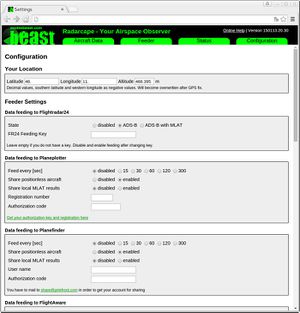
Fixes:
- no data sent via delta DB file
Release_140922.19.03
New Features:
- In addition to Flightradar24 and Planeplotter, the Radarcape can now easily feed the current aircraft list to Planefinder and FlightAware servers. See the configuration menu how to register at their servers as a feeder. You can select the feeding interval separately for each in steps by 15, 30, 60, 120 and 300 seconds. There is a random value added in order to spread the feeding events a little over time.
Changes:
- The main menu and the configuration menu became redesigned for a better readability.
- Feeder status shows some more information, e.g. the true FPGA settings and the server's respose.
Fixes:
- The feeding of data is now coupled to the trust level of an entry. It must be at least 2 in order to upload data to a server. This should prevent ghost aircraft from beeing transmitted. Regular aircraft easily exceed this number within a very short time, so there is no real delay in announcing them to others. This feature should allow FEC beeing switched on in some more situations.
- Omit time should now be used in all maps and tables correctly.
- In the 2D map some aircraft appeared at 0°/0° coordinates after some time. That is fixed now.
Release_140412.08.49
New Features:
- none
I am currently working for the Peer-to-Peer MLAT, which is basically working with very precise results, however the communication between the Radarcapes has proven to be unstable and so needs a redesign.
Changes:
- New FR24 feeder
- Some performance increase with Port 30003 data output
- The Flightroutes link parser was changed to handle the new structure of the links
Release_140209.18.32
New Features:
- Decodes flight identification from DF20/DF21 frames (thanks, Bev)
- Decodes speed/heading from DF-17 subtype 3+4
- Automatic control of FR24 feeder setting change. No longer needs to manually sequence a setting change.
- Prepeared for next release to be installed with web GUI command. With this, it does not need to go into Linux when you want to install a software update
- The 3D map opens correctly with Windows 7
Changes:
- New FR24 MLAT capable feeder release 20140127-1444
- Some cosmetic changes
- Planeplotter sharing feeder in some cases contained false flight names
Install command:
opkg update
opkg install -V http://www.modesbeast.com/resources/radarcaped-140209.18.32.opk
Release_140124.08.32c
New Features:
- Supports type information and routes information from common databases. This is displayed in aircraft list and 3D output currrently, it will become displayed in 2D and JSON output with next release. Origin and Destination are split, so you can sort for both in the aircraft list.
- There is a new Maintenance web page in the Radarcape where the links to the zipped archives can be pasted into, after pressing Update button the database is fetched from the server, unzipped and becomes installed. The whole update procedure is displayed in the web browser.
Note: Flightroute emails mostly contain a short link to the archive. Following this link is not included here, you always must copy the final ZIP archive link. This link also invalidates after a while, so in case of problems, referesh the page displaying it and use the new link.
It does not matter if you prefer the 3 letter or 4 letter database, Radarcape will handle both.
Changes:
- New FR24 MLAT feeder: This feeder connects to raw data port, no longer to Port 30003. Its options for aircraft sharing and MLAT data sharing can be controlled through Radarcape's configuration dialogue. Note that the CPU load is somewhat more than the old feeder.
- The former field 'Ident' became renamed to 'Flight'
Install command:
opkg update
opkg install -V http://www.modesbeast.com/resources/radarcaped-140124.08.32c.opk
Release_140106.19.14
New Features:
- Planeplotter sharing upload for positionless aircraft can be disabled now
Changes:
- uploading to Planeplotter uses upper case 6 digit ICAO id
Install command:
opkg install -V http://www.modesbeast.com/resources/radarcaped-140106.19.14.opk
Release_140106.13.29 - Planeplotter Feeder, Ground Decoding
New Features:
- Planeplotter aircraft sharing added
This is the first release which publishes the current known aircraft to the Planeplotter network. Uploading can be enabled and disabled. You need to get a sharing authorisation, whichis explained in the configuration dialogue. There is also a status page and a link provided to the Planeplotter server which shows your past uploads. Uploading is currently done once every minute plus a random 0...14 sec. (The uploading methode was prepared for R-Pi, Bev needs to rename the service now.)
MLAT support will be added as soon as possible.
- Ground decoding
Ground data is decoded. It is output in all services.
Changes:
- The Flightradar24 Feeder can now be started based on the internal deltaDB methode or Port 30003 data, as some users felt that if based on Port 30003 the acceptance rate at FR24 is higher than based on deltaDB. Please note that Port 30003 is a very inefficient protocol and consumes more CPU resources than deltaDB.
- The feeders now start only if the GPS time is available. Timestamps on web status pages contain an (X) if unknown time source, (C) if the CPU time is used and (G) if GPS time is present.
- Port 30003 output data contains GPS timestamp if available.
Install command:
# original version overwritten by 19.14
opkg install -V http://www.modesbeast.com/resources/radarcaped-140106.19.14.opk
Release 131225.18.56
New Features:
- Remote control of FPGA configuration ("DIP switches") can be enabled and disabled in configuration
Solves:
- Timestamp problem: All timestamps are based on the GPS time. If not available CPU time is used
Install command:
opkg install -V http://www.modesbeast.com/resources/radarcaped-131225.18.56.opk
Release 131206.22.40
New Features:
- 2D map automatically centers on your GPS position and zooms according to your current largest distance.
Solves:
- Internet Explorer may not be display the web pages at all, Mozilla Firefox seems to be tolerant. Radarcape currently does not send the correct HTML header.
Install command:
opkg install -V http://www.modesbeast.com/resources/radarcaped-131206.22.40.opk
Release 131202.20.55
New Features:
Solves:
- KML starter did not access KML output -> Google Earth 3D view did not work
Install command:
opkg install -V http://www.modesbeast.com/resources/radarcaped-131202.20.55.opk
Release 131128.21.18: Introduction of 2D Maps
New Features:
- 2D map display on web browser
Solves:
Install command:
opkg install -V http://www.modesbeast.com/resources/radarcaped-131128.21.18.opk
Release 131127.05.01: Solves P30003 message type problem
New Features:
- none
Solves:
- The port 30003 messages MSG,2 and MSG,3 seem to be swapped. ==> actually all Port 30003 messsages were one count too low.
Install command:
opkg install -V http://www.modesbeast.com/resources/radarcaped-131127.05.01.opk
Release 131126.19.46: Configuration Page Issues Solved
New Features:
- none
Solves:
- The configuration page when beeing saved does not confirm change but show an empty page or a failure message. However the changes appear to be taken. It only happens on a few installations. Investigation is in progress.
- There was a delay when connecting to a TCP port, which is now avoided.
- HTML 'Back' link moved to the top of all pages
- Timestamp behaviour in P30003: Is now truely message generation and message capture time.
- uses GCC 4.3.3 and Boost 1.53.0
Install command:
opkg install -V http://www.modesbeast.com/resources/radarcaped-131126.19.46.opk
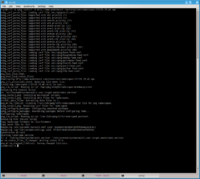
FPGA Firmware
Firmware update on the Radarcape is absolutely simple: Just mount the Radarcape as a drive into your Windows, then replace the existing meaADSB.rbf file with the one downloaded from this web page. You may save the existing one, but the history also exists here for download (including the version name in the file name).
The GPS timestamp
The GPS timestamp is completely handled in the FPGA (hardware) and does not require any interactions on the Linux side. This is essential to meet the required accuracy. The local clock in the FPGA (64MHz or 96MHz) is stretched or compressed to meet 1e9 counts in between two pulses by a linear algorithm, in order to avoid bigger jumps in the timestamp. Rollover from 999999999 to 0 occurs synchronously to the 1PPS leading edge. In parallel, the Second-of-Day information is read from the TSIP serial data stream and also aligned to the 1PPS pulse. Both parts are then mapped into the 48bits that are available for the timestamp and transmitted with each Mode-S or Mode-A/C message.
- SecondsOfDay are using the upper 18 bits of the timestamp
- Nanoseconds are using the lower 30 bits. The value there directly converts into a 1ns based value and does not need to be converted by sample rate
In C
nanosec = (msg[2] & 0x3f) << 24
| msg[3] << 16
| msg[4] << 8
| msg[5];
daysec = msg[0] << 10
| msg[1] << 2
| msg[2] >> 6;
if (daysec_tm1!=daysec)
{
daysec_tm1 = daysec;
hh = (daysec/3600) % 24;
mm = (daysec/60) % 60;
ss = daysec % 60;
}
Example:
Timestamp of 1019UTC: 0x244bbb9ac9f0
lower 30 bits are 0x3b9ac9f0 => Nanosecond = 999999984 * 1e-9
upper 18 bits are 0x912e => daysec = 37166
hour = 37166/3600 = 10
minute = 37166 / 60 modulo 60 = 19
second = 37166 modulo 60 = 26
So time is 10:19:26.999999984 after UTC midnight
The legacy 48bit and 12MHz based timestamp however is not synchronized to 12MHz at all, so it still works as it has been since ever.
Linux and FPGA firmware package ppsjump-021 (23. Aug. 2013)
Corrections
- For enhanced stability, this version is based on Linux 3.8.
- The GPS tool is now included into the radarcape deamon. It also provides a GPS status through the web server, accessing gps.html on the integrated webserver
- The TCP ports for data streaming connect on each try, not each second.
Installation
For this version, it is essential that you update your SD card completly from scratch. Download the naked Linux 3.8 image (73MB) and make a SD card as described in Radarcape Linux Install/Configure. Please mind the two screenshots there in order to see how about the update procedure works like. (As some users had problems unpacking the XZ, there is a Linux 3.8 image ZIP Version (130MB) on the server, too)
When inserted and rebooted, either login through the serial port (Mini-USB on the back side) or via SSH/network (then your destination temporarily is “beaglebone”). Enter these commands, and don't forget to enter your known Radarcape ID when beeing asked from the skript:
cd
rm install38.sh
wget http://www.modesbeast.com/resources/install38.sh
sh ./install38.sh
reboot -f
FPGA Firmware meaADSB_ep3_143_ppsjump-020
Corrections
The GPS timestamp locked on multiplies of 32768 in situations when the 1PPS signal was disturbed by external matters.
superseeded by ppsjump-021
FPGA Firmware meaADSB_ep3_141_gpsmlat-3
Corrections
SecondOfDay (the upper 18 bits of the timestamp in GPS mode) and Nanoseconds (the lower 30 bits) are now synchronized.
Note that in order to overcome above problem with negative timestamps, the GPS read: absolute timestamp of Mode-S and Mode-A/C frames is taken at the end of the frame, at least until further notice. This does not make any difference for multilateration, as long as this feature is unique provided by the Radarcape.
Firmware meaADSB_ep3_141_gpsmlat-3
md5sum meaadsb_ep3_141_gpsmlat-3.rbf
86d6cdb069868e4f57d47dfc3441593c meaadsb_ep3_141_gpsmlat-3.rbf
md5sum meaadsb_ep3_141_gpsmlat-3.zip
5bcae05ea429b4ef943b303314e22b82 meaadsb_ep3_141_gpsmlat-3.zip
FPGA Firmware meaADSB_ep3_141_gpsmlat-2
Firmware meaADSB_ep3_141_gpsmlat-2 has a working GPS timestamp function. Therefore, DIP#5 switch selects either the standard 12MHz timestamp (when off) or the GPS timestamp (when on).
md5sum meaADSB_ep3_141_gpsmlat-2.rbf
dc7a6278a668b1bdb81fd67e7a1891a6 meaADSB_ep3_141_gpsmlat-2.rbf
md5sum meaADSB_ep3_141_gpsmlat-2.zip
ba54740894406cb38e8dd95d0fc3e3e8 meaADSB_ep3_141_gpsmlat-2.zip
| Radarcape DIP Switch | DIP#1 | DIP#2 | DIP#3 | DIP#4 | DIP#5 | DIP#6 | DIP#7 | DIP#8 |
|---|---|---|---|---|---|---|---|---|
| Equivalent Beast DIP with resp. to PP setting |
DIP#3 | DIP#4 | DIP#5 | DIP#6 | DIP#7 | DIP#8 | DIP#9 | DIP#10 |
| When ON | Binary format | only DF-11 and DF-17 |
enable MLAT in AVR format |
CRC check disabled |
GPS based timestamp |
RTS hardware handshake |
1 Bit FEC disabled |
Mode-A/C decoding enabled |
| When OFF | AVR format | all usable DF | no MLAT in AVR format |
CRC check enabled |
standard 12MHz timestamp |
hardware hand- shake disabled |
1 Bit FEC enabled |
Mode-A/C decoding disabled |
| Command Character |
c/C | d/D | e/E | f/F | g/G | h/H | i/I | j/J |
| not used in binary format |
An upper case character is equal to a DIP that is in ON position, a lower case character equal to DIP in open position
The green LED next to the SMA connector is used as GPS indicator:
- Short on, long off: Just 1PPS is present, but no time of day information
- On and off time equal: 1PPS present, Time of day present, but there is a synchronisation offset
- Long on, short off: 1PPS present, Time of day present, Internal time is synchronized to GPS
It is not a problem if the clock sometimes falls back from (3) to (2), because the sensitivity of synchronisation check is +/-1 tick.
The center red LED flashes as an indication of operating about twice per second. It should flash very fast in case that hardware handshake is active.
The GPS based timestamp still uses the standard 48 bits as known from the 12MHz timestamp, but in different way:
- the lower 30 bits are the time since the last 1PPS pulse, in 1ns steps, currently 15ns resolution
- the upper 18 bits are the Seconds-Of-Day, starting with zero at midnight UTC
Known Issues (meaADSB_ep3_141_gpsmlat-2)
- Within the GPS timestamp, the Second-Of-Day part advances in the mid of the 0-999999999ns phase ⇒ next version
- Sometimes the Second-Of-Day part does not increment at the rollover of the nanosecond part ⇒ next version
- The absolute value of the GPS timestamp of 14 bytes long Mode-S frames is offset, however since all units do have that error, it is not a big problem for multilateration ⇒ wait for release
- Negative delta time offsets between consequent frames ⇒ not an issue (see below)
Negative delta time between consequent frames
If you look at the block diagram of the Mode-S Beast, recognize that there are several frame decoders working in parallel, plus the Mode-A/C decoder, which is not yet mentioned in the picture. They all work independently, their output - a ready frame - is written into a FIFO in order to buffer it for RS232 transmission.
It now may happen that during the reception of a Mode-S frame, an overlapping Mode-AC frame becomes decoded in parallel and is written into the FIFO, prior to the end of the Mode-S frame. Since the timestamps are taken at the start of frame, in that situation, the Mode-AC frame with a later timestamp is written to the FIFO before the Mode-S frame finishes. Consequentally on the output, the later timestamp of the Mode-S frame appears ahead of the Mode-S frame's.
It is easy to understand with the Mode-AC as a cause, but the same happens if one of the noise decoders or the overlapping Mode-S frame decoder outputs a frame while the other is still working.
Sorting that in the FPGA would cost too many ressources, so users of the timestamps anyway need a matching algorithm among different units, so that algorithm should be aware about this situation.
If you think about swapping them around, note that it may not happen with two frames but several, e.g. in the situation that two Mode-A/C frames do overlap a 14 byte Mode-S frame.


